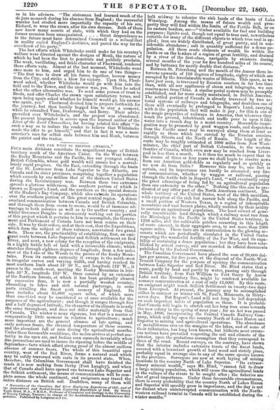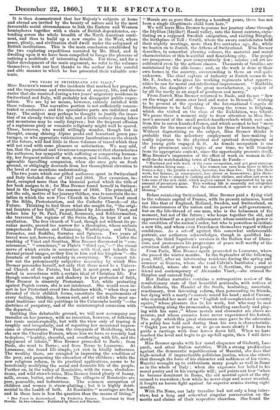THE PAR WEST OF BRITISH AMERICA. * THE PAR WEST OF
BRITISH AMERICA.* FOUR main divisions constitute the magnificent range of British territory north of the American Union. On the West between the Rocky Mountains and the Pacific, lies our youngest colony, British Columbia, whose gold wealth will ensure her a marvel- lously rapid progress. On the East, extending through the basin of the St. Lawrence from Lake Superior to the Atlantic, are Canada and its sister provinces, comprising together a population which exceeds by one million that of the thirteen United States during the Revolutionary war. Between these two extremes spreads a glorious wilderness, the southern portion of which is known as Rupert's Land, and the northern as the special domain of the Hudson's Bay Company, which also extends its operations over the southern portion of this great central region. A direct overland communication between Canada and British Columbia, and through them from ocean to ocean, would be of immense ad- vantage to both colonies as well as to the mother country ; and whilst Governor Douglas is strenuously working out the portion of this project which it pertains to him to accomplish, the Govern- ment and Parliament of Canada have not been remiss on their side. It was by their orders, and at their cost, that the Expeditions, which form the subject of these volumes, ascertained two grand facts. These are, the practicability of establishing, first, an emi- grant route between Lake Superior and Selkirk settlement on Red River, and next, a new colony for the reception of the emigrants, in a highly fertile belt of land with a favourable climate, which stretches through eighteen degrees of longitude, from a few miles west of the Lake of the Woods to the passes of the Rocky Moun- tains. From its eastern extremity it sweeps to the north-west in irregular curves and varying width, and having reached its most northern limit about 54° 30' N., and longitude 112° W., it passes to the south-west, meeting the Rocky Mountains in lati- tude 51° N., longitude 115° W. Once covered by an extension of the Northern forests, of which it has been gradually cleared by successive fires, it is now a partially wooded country, abounding in lakes and rich natural pasturage, in some parts rivalling the finest park scenery of England. Its area includes about 65,000 square miles, of which more than one-third may be considered as at once available for the purposes of the agriculturist ; and though it ranges through five and a half degrees of latitude, the character of its climate is nearly the same throughout, and does not differ materially from that of Canada. The winter is more rigorous, but that is a matter of comparatively little moment in relation to agriculture ; much more important are the general absence of late spring, and early autumn frosts, the elevated temperature of those seasons, and the abundant fall of rain during the agricultural months. Under these favourable conditions, the melon arrives at perfect ma- turity in the open air, and Indian corn succeeds invariably when due precautions are used to insure its ripening before the middle of September—facts which afford strong proof of the almost uniform absence of summer frosts. The whole of this beautiful open country, west of the Red River, forms a natural road which may be safely traversed with carts in its present state. When, therefore, the Columbian Government shall have finished the roads it is now making from Derby (Fort Langley), and when that of Canada shall have opened one between Lake Superior and the Selkirk settlement, the means of communication will be com- plete across the whole continent, and emigrants may travel the entire distance on British soil. Doubtless, many of them will
• Narrative of the Canadian Red Ricer Exploring Expedition of 1857, and of the dssinniboine and Saskatchewan Exploring Expedition of 1858. By Henry Youle Hind, 31.A., F.R.G.S., Professor of Chemistry and Geology in the University of Trinity College, Toronto ; in charge of the Assinniboine and Saskatchewan Ex- pedition. Published by Longman and Co.
halt midway to colonize the rich lands of the basin of Lake Winnipeg. Among the means of future wealth and pros-
perity they will find within the limits of the Fertile Belt, or on its eastern borders, are—" timber available for fuel and building purposes; lignite coal, though not equal to true coal, nevertheless suitable for many of the different objects to which true coal is ap- plied; iron ore widely distributed, of great purity, and in con- siderable abundance ; salt in quantity sufficient for a dense po- pulation. All these crude elements of wealth lie within the limits or on the bezders of a region of great fertility, and drained by a river of the first-class, navigable by steamers during several months of the year for five hundred miles of its course, and by batteaux for nearly double that distance." Between St. Petersburg and the mouth of the Amoor there in- tervene upwards of 110 degrees of longitude, eighty of which are occupied by the irreclaimable wastes of Siberia. This space, as we have just seen, is traversed by Russian couriers in far less time than, with all our appliances of steam and telegraphs, we can receive news from China. A similar postal system may be promptly established, and far more easily maintained, in British America. The settled portion of Canada is already traversed by two ar- terial systems of railways and telegraphs, and doubtless one of these will eventually be prolonged to Rupert's Land, carrying with it the population that will make it pay ; for this is one of the magic properties of railways in America, that wherever they touch the ground, inhabitants and traffic pour in upon it like water into a trench dug in a moist country. Meanwhile immi- gration may be promoted by good waggon roads, and despatches from the Pacific coast may be conveyed along them at least as rapidly as those which are carried by the Russian couriers through Siberia and the North of Russia. The length of the route may be roughly estimated at 1000 miles from New West- minster, the chief port of British Columbia, to the western frontier of Canada, which even now may be reached from Liver- pool in less than a month. Is it then too much to expect that in the course of three or four years we shall begin to receive news from our American gold-fields as regularly and. as quickly as we now do from India ? However this may be, one fact is certain, and its importance can hardly be overrated : any line of communication, whether by waggon or railroad, passing through the fertile belt in Rupert's Land, "will eventually enjoy the great advantage of being fed by an agricultural population from one extremity to the other." Nothing like this can be pre- dicated of any other part of the North American continent. The whole territory of the United States, west of the 98th meridian, with exception of the rich but narrow belt along the Pacific, and a .small portion of Western Texas, is a region of inhospitable mountains and vast barren plains, wholly unfitted by their aridity to sustain an agricultural population. The least extent of gene- rally uncultivable land through which a railway must run from the Mississippi to the Pacific in the United States territory, is 1210 miles, and the cultivable patches occurring in this length of route amount, in their aggregate area, to not more than 2300 square miles. These facts are in contradiction to the glowing ac- counts which are periodically circulated in the United States respecting the wonderful fertility of the Far West, and its capa- bility of sustaining a dense population ; but they have been esta- blished by actual survey, and are recorded in official documents published by the Federal Government. The Canadian Government have placed the sum of 20,000 dol- lars per annum, for five years, at the disposal of the North-West Transit Company for the purpose of opening the communication between Lake Superior and Red River. Mr. Hind states that a route, partly by land and partly by water, passing only through British territory, from Fort William to Fort Garry by Arrow Lake and the Boundary line, might be rendered available for summer communication at a cost of only 12,0001. By this route, an emigrant might reach Selkirk Settlement in twenty-two days from Liverpool. At present, the journey may be accomplished either in summer or winter via St. Paul's, Minnesota, in thirty- seven days. But Rupert's Land will not long be left dependent on such imperfect inlets of population as these. It is probable that Canada will begin to stretch out her long iron arms towards the new colony in the spring of next year ; for an Act was passed in May, 1860, incorporating the Central Canada Railway Com- pany, which will lay open the country North of Lakes Huron and Superior to mining and agricultural operations. The abundance of metalliferous ores on the margins of the lakes, and of some of their tributaries, has long been known, but hitherto most errone- ous notions have prevailed respecting the soil and climate of the interior, upon the gratuitous assumption that they correspond to those of the coast. Recent surveys, on the contrary, have shown that the interior includes extensive tracts of the finest lands, covered with a luxuriant growth of hard wood and stately pines, probably equal in average size to any of the same species known in the province. Surveyors are now at work laying off mining locations in the country North of Lake Superior. "Its extraor- dinary mineral wealth," says Mr. Hind, "cannot fail to draw a large mining population, which will cause the agricultural lands in the valleys of the rivers to be sought after ; the fisheries are also of great importance. Under these favourable circumstances, there is every probability that the country North of Lakes Huron and Superior will speedily grow in importance, and the day is not far distant when uninterrupted communication with the North- western railroad termini in Canada will be established during the winter months."
It is then demonstrated that her Majesty's subjects at home and abroad are invited by the bounty of nature and by the most favourable social circumstances to link the Eastern and Western hemispheres together with a chain of British dependencies, ex- tending across the whole breadth of the North American conti- nent, and thus to build up a new empire in the West, where peace, plenty, and civilization shall dwell under the safeguard of British institutions. This is the main conclusion established by the two exploring expeditions narrated by Mr. Hind, and in dwelling upon it we have been compelled to forego the pleasure of noticing a multitude of interesting details. For these, and for a fuller development of the main argument, we refer to the volumes themselves, with our best thanks to the author for the careful and able manner in which he has presented their valuable con- tents.



























 Previous page
Previous page